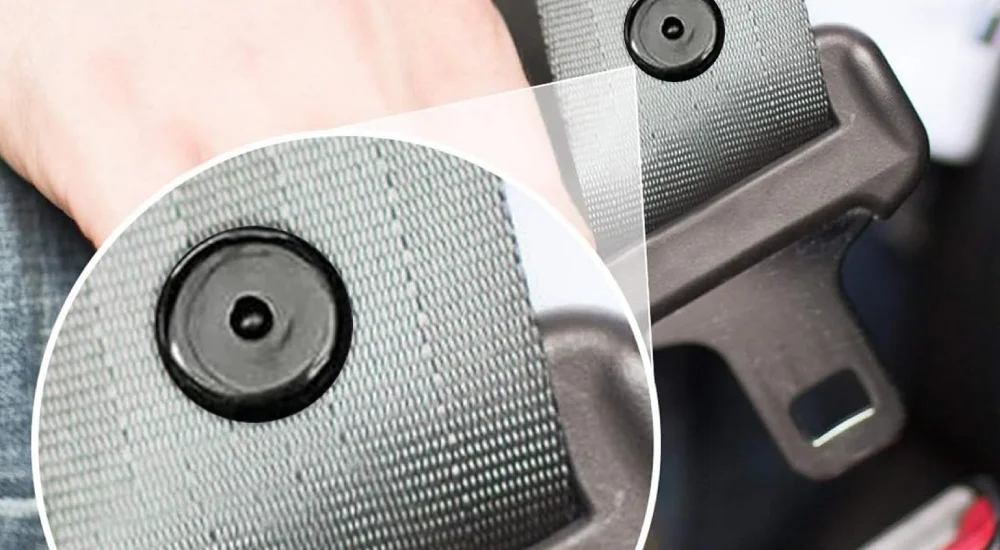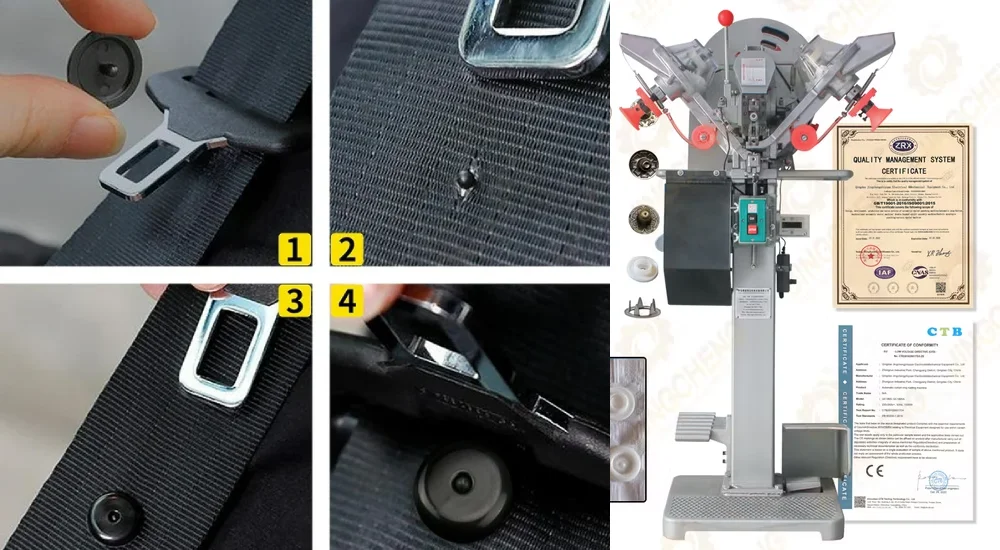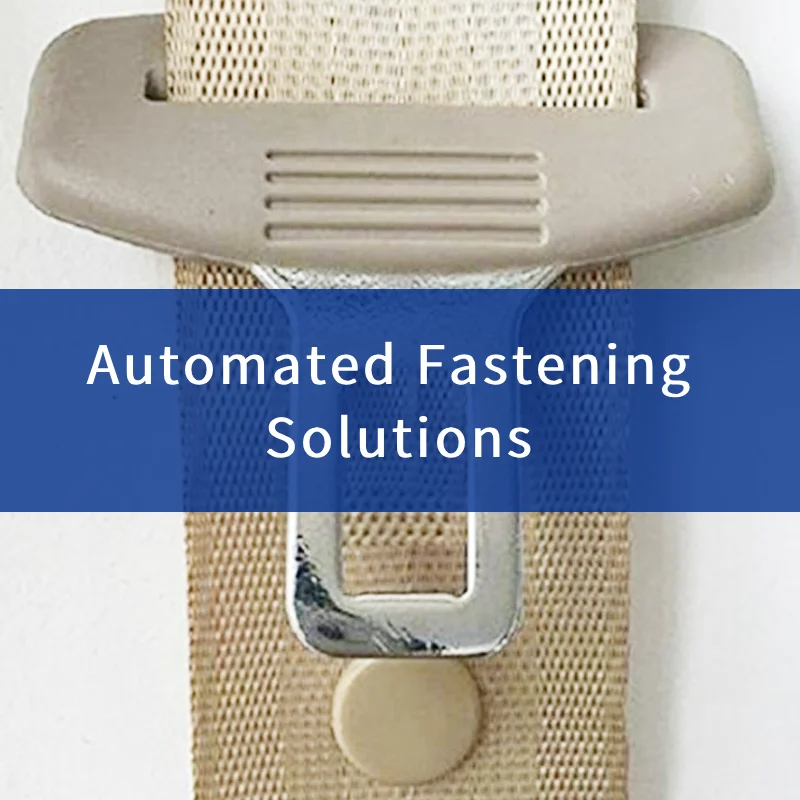If you’ve ever buckled up in your car and felt that solid “click” when you pull the belt across your chest, you’re experiencing a small but critical piece of safety engineering — the seat belt button stop. This little component prevents the buckle from sliding too far down the belt, ensuring it stays in the perfect position every time. It may look simple, but when it comes to passenger safety, even millimeters matter.
Over the years, our team has worked closely with automotive manufacturers, suppliers, and safety engineers, and one lesson stands out — consistency saves lives. A slightly misaligned button could cause discomfort, delay fastening, or even affect the locking mechanism’s reliability in extreme cases. That’s where the Automatic Snap Button Machine comes in — designed to ensure every button is applied precisely where it needs to be, every single time.
In this article, we’ll take you behind the scenes of how automatic fastening is transforming seat belt production, making it faster, safer, and more reliable than ever before.

Snap Button and Its Role in Seat Belts
Snap buttons, sometimes referred to as “button stops” in the automotive industry, are more than decorative components — they’re functional safety features. In a seat belt, these buttons define the stop point for the buckle tongue, ensuring it remains easily accessible when you reach for your belt.
Traditionally, these buttons were applied manually, often using handheld presses or semi-automatic machines. While functional, manual methods leave room for variability in alignment, pressure, and penetration — all of which could compromise quality. In contrast, an Automatic Snap Button Machine applies consistent pressure, verifies positioning, and completes each fastening within seconds.
In our years manufacturing these systems, we’ve refined the process to minimize material stress and maximize holding strength. Each button application is controlled by precise pneumatic or servo-driven mechanisms, ensuring repeatable quality across thousands of belts.
It’s the kind of precision only automation can achieve — and it’s why leading OEMs now rely on automated fastening to meet both SAE J386 and ISO 6683 standards for seat belt performance and durability.
Challenges in Manual Seat Belt Button Installation
Before automation, button installation was often a bottleneck in production. Operators had to align each button by eye, position the belt correctly, and apply the press manually. Even with training, inconsistencies would occur — slight shifts, uneven pressure, or premature tool wear could all lead to rework or product rejection.
We’ve seen this firsthand when auditing factories transitioning to automation. Some were losing up to 12% of output to quality issues related to manual fastening. Even when defects were minor, inspection and correction ate up valuable labor hours. Worse, manual tools expose workers to repetitive strain injuries over time.
Our experience in the field taught us that automation doesn’t just improve speed — it improves safety, ergonomics, and workforce satisfaction. Once the Automatic Snap Button Machine was installed, those same factories reported up to 95% reductions in button misalignment and a dramatic boost in overall throughput.
How the Automatic Snap Button Machine Transforms the Process

Here’s where things get exciting. The Auto Snap Button Machine doesn’t just replicate human work — it enhances it. Each step, from feeding the button parts to applying them on the fabric, is controlled by an integrated logic system. Operators simply place the belt under the applicator, and the machine does the rest — automatically aligning, pressing, and verifying the result.
Depending on model and configuration, our machines can apply up to 40–60 snap buttons per minute, all while maintaining uniform pressure and depth. That’s not just speed — that’s consistency you can trust.
What’s equally impressive is how easy it is to use. The touchscreen interface allows quick setup changes, so you can switch between seat belt types or button sizes in seconds. And thanks to built-in sensors, the machine immediately detects if a button is missing, misaligned, or under-pressed, stopping the process to avoid wastage.
When customers see this in action for the first time, their reaction is always the same — a mix of surprise and relief. “It’s like having a professional who never gets tired,” one of our clients in Michigan once said. We couldn’t have said it better.
Inside the Machine: How It Works
At its core, an Automatic Snap Button Machine is a fusion of precision mechanics and smart control systems. Every function — from button feeding to pressure control — is designed to remove human error and ensure flawless fastening.
Let’s break it down simply. The machine begins with a vibratory feeder that separates and aligns snap button components automatically. This ensures that the male and female parts are perfectly oriented before they even reach the pressing unit. Then, an optical sensor verifies component presence to avoid dry pressing — a common issue in manual operations that can damage belts or tools.
Next comes the pressing stage. Here, the servo or pneumatic press applies a consistent and calibrated force, measured down to fractions of a Newton. This ensures the button is securely anchored without damaging the belt fabric. The PLC control system then checks the pressing cycle time, pressure, and button depth. If anything falls outside tolerance, the machine immediately alerts the operator.
Modern models — including our latest line — integrate touchscreen HMI panels with multilingual menus. Operators can easily set button distances, control feeding intervals, and monitor real-time statistics like output count and efficiency. Maintenance has also become simpler; quick-release dies and modular tool heads allow technicians to switch setups in under 10 minutes.
To put it simply, the machine is built to think, react, and perform better than manual processes — delivering consistency that meets both automotive and aerospace fastening standards.
Meeting Industry Standards and Safety Requirements
Seat belts aren’t just comfort features — they’re regulated safety systems governed by strict international standards. Every single component, including the snap button stop, must meet defined durability and strength criteria before approval.
For instance, ISO 6683 and SAE J386 outline the performance requirements for restraint systems used in on-road and off-road vehicles. These regulations specify that all fastening points must resist slippage, fatigue, and mechanical deformation over time. Meanwhile, automotive OEMs often impose even tighter internal standards — for example, tolerance margins under ±0.2 mm for button positioning.
Our Automatic Snap Button Machines are designed to help manufacturers meet and exceed those standards. Each press cycle is precisely controlled, ensuring consistent insertion depth and clamping force. We’ve also developed calibration systems compliant with ISO 9001:2015 quality management requirements, so customers can track every production run with full traceability.
Beyond compliance, our engineers collaborate directly with safety labs and certification bodies to validate fastening strength and environmental resistance. Every test we conduct — from high-temperature durability to humidity exposure — adds confidence that the final product won’t fail when it matters most.
Safety isn’t a marketing term in our industry; it’s a responsibility. And automation ensures that responsibility is met with measurable reliability, not human variability.
Quality Assurance: Precision That Builds Trust
When you install thousands of seat belts a day, consistency isn’t optional — it’s everything. The smallest inconsistency in a button’s placement can cause long-term mechanical fatigue or interfere with belt retraction. That’s why automated fastening isn’t just about speed; it’s about precision that builds trust.
Our machines are equipped with real-time monitoring systems that log every fastening event. Operators can export performance data, review reject rates, and even visualize button pressure graphs. This data-driven approach helps production teams identify potential issues before they cause downtime or product waste.
We also conduct random batch inspections using digital force gauges to verify holding strength. Over years of testing, the results have been remarkably consistent: automated fastening improves repeatability by up to 98% compared to manual installation.
One of our long-term partners — a seat belt manufacturer in South Korea — shared that since switching to automation, their warranty claims dropped by 75%. Another European distributor told us their clients now ask specifically for “automated-fastened belts,” citing visibly better finishing and alignment.
Trust, once earned through technology, becomes your brand’s reputation. And that’s something we never take lightly.
Voices from the Field: Feedback from Manufacturers and Distributors
We believe that real proof of value doesn’t come from our words — it comes from our customers’ experiences. Over the years, we’ve collected feedback from OEMs, suppliers, and global distributors who rely on our machines daily.
A major seat belt producer in Mexico described the transformation best:
“Before automation, our workers were exhausted by repetitive pressing tasks. Now, the Auto Snap Button Machine handles it effortlessly. Our productivity doubled, and quality issues nearly disappeared.”
Another distributor in Eastern Europe highlighted the reliability factor:
“We’ve run the same machine for over four years with minimal downtime. The maintenance alerts and auto-lubrication system make it incredibly easy to operate. It’s one of those rare machines that feels built to last.”
We also receive regular appreciation from smaller workshops transitioning from manual to automated processes. One client, a start-up in Indonesia, shared how the automation gave them a competitive edge:
“It made us look like a big manufacturer overnight. The consistency and finish quality elevated our products instantly.”
Hearing stories like these fuels our innovation. They remind us that automation isn’t about replacing people — it’s about empowering them to produce safer, better, and more profitable products.
Cost Efficiency and Long-Term ROI
It’s easy to view automation as a large upfront investment, but the truth is — the Automatic Snap Button Machine pays for itself much faster than most expect. Let’s break it down.
In a typical seat belt assembly line, manual button installation may require 3–4 workers, each handling a few hundred units per shift. With automation, a single operator can oversee a machine applying 2,500–3,000 buttons per shift with near-zero rework. That’s a direct productivity increase of up to 400%.
Now consider the reduced material waste and labor fatigue. Automation ensures every press is perfect, which means fewer rejected belts, fewer quality audits, and faster throughput. When you calculate those savings, most customers report full ROI within 6 to 12 months of operation.
Beyond cost savings, automation stabilizes production costs against fluctuating labor markets — a key advantage in global supply chains. It also enhances traceability, a growing requirement for large OEM contracts.
Our internal data shows that factories using automated fastening experience 40% less downtime and up to 30% lower total production costs. When efficiency meets reliability, ROI isn’t just financial — it’s operational peace of mind.
Maintenance and Operation: Simple Yet Smart
One of the misconceptions about automation is that it’s complicated to maintain. The truth? Our Automatic Snap Button Machines are designed with simplicity and longevity in mind.
Every component is modular — from the feeder bowls to the die heads — allowing quick replacement or servicing. The interface provides maintenance reminders, self-diagnostic reports, and even video tutorials for basic troubleshooting. Operators don’t need advanced technical backgrounds; most can learn to operate the system confidently within a single training session.
Our machines also feature auto-lubrication, air-pressure balancing, and temperature monitoring systems. These features protect internal mechanisms from wear and ensure optimal performance across long shifts.
From experience, we’ve seen that regular maintenance — even just 15 minutes per week — can extend the machine’s lifespan by over five years. And when service is needed, our engineers provide remote support or on-site assistance globally, ensuring minimal downtime.
Automation should make life easier, not harder. That’s why we build our machines to be as user-friendly as they are powerful.
Environmental Impact and Sustainable Production
Sustainability isn’t just a trend — it’s an expectation. Automotive brands today demand environmentally responsible production processes, and automation helps achieve exactly that.
The Automatic Snap Button Machine reduces waste through precision. Since every press is accurate, there’s virtually no material scrap. The pneumatic systems are designed for low air consumption, and electric servo presses use up to 40% less energy than older hydraulic models.
Moreover, our factory partners have reported significant reductions in noise pollution and heat output compared to manual or semi-automatic methods. Some even integrate solar energy to power their automation lines — a step toward fully green manufacturing.
In compliance with RoHS and REACH environmental standards, our machines are built from recyclable materials and designed for long service life. For us, sustainable engineering isn’t a bonus — it’s a core value.
Innovation in Motion: AI and Smart Sensors in Modern Machines
As automation evolves, intelligence becomes the next frontier. Our latest models incorporate AI-based defect detection, using smart sensors and vision systems to analyze every button installation in real time. If the AI detects an anomaly — even one invisible to the naked eye — it flags it instantly for review.
We’ve also implemented adaptive pressure control, which automatically adjusts the pressing force based on belt thickness and material composition. This is crucial when dealing with multi-layer seat belts or special textiles used in luxury vehicles.
Connectivity is another game-changer. With IoT-enabled dashboards, supervisors can track performance remotely, monitor error logs, and schedule predictive maintenance. In fact, one of our clients in Germany reduced downtime by 27% simply by enabling live data monitoring through our cloud platform.
This level of intelligence doesn’t just make machines smarter — it makes production more transparent, efficient, and future-ready.
Comparing Traditional vs. Automated Fastening Methods
| Aspect | Manual Installation | Automatic Installation |
|---|---|---|
| Speed | 200–400 buttons/hour | 2,500–3,000 buttons/hour |
| Accuracy | ±1.0 mm deviation | ±0.1 mm deviation |
| Operator Fatigue | High | Minimal |
| Reject Rate | 8–12% | <1% |
| Maintenance Cost | Frequent | Low |
| ROI Period | — | 6–12 months |
The difference is clear. Automation doesn’t just make production faster; it makes it smarter, safer, and more predictable.
Global Demand and Market Trends in Seat Belt Manufacturing
The global seat belt market is growing at a steady pace, driven by increased safety regulations and consumer awareness. Automation has become a defining feature of modern factories, especially in countries like China, the U.S., Germany, and Japan.
Analysts project that the demand for automotive safety components will reach over USD 30 billion by 2030, with a strong emphasis on automated assembly and traceable quality assurance. Our experience mirrors this trend — over 70% of our new clients are first-time adopters of automation, recognizing its necessity for scaling production competitively.
This shift represents not just a technological upgrade, but a mindset change: from reactive manufacturing to proactive quality assurance.
Why Our Automatic Snap Button Machines Stand Out
We’ve spent decades refining our machines — and we don’t stop at hardware. Our advantage lies in customization. Every client’s workflow is different, so we design modular systems that adapt to their belt materials, button types, and production speed requirements.
We also provide full documentation, including CE certification, user manuals, and safety compliance reports, ensuring worry-free integration into existing assembly lines.
Most importantly, we treat every customer as a partner. Whether you’re a global OEM or a regional workshop, we commit to helping you improve efficiency and quality without compromise.
Training, After-Sales Support, and Partner Success
Purchasing automation is only the first step — mastering it is where true value begins. That’s why we invest heavily in training programs, video guides, and on-site setup support.
Our technical team offers 24/7 remote assistance and maintains a comprehensive online portal where clients can download manuals, troubleshooting tips, and firmware updates. For larger partners, we even provide custom maintenance contracts that include periodic audits and predictive maintenance visits.
Because automation is a long-term partnership, not a one-time sale.
Conclusion
Every time a seat belt saves a life, a series of precise engineering choices stand behind it — from the weave of the fabric to the strength of the button stop. Our Automatic Snap Button Machines play a quiet but vital role in that chain, ensuring each button holds firm, every time, without fail.
We don’t just build machines; we build confidence — confidence in quality, in safety, and in innovation. And as technology continues to evolve, we’ll keep pushing forward, ensuring our partners always stay one step ahead in reliability, precision, and trust.
FAQs
What materials can the Automatic Snap Button Machine work with?
It’s compatible with polyester, nylon, and other automotive-grade fabrics, as well as leather and technical textiles used in premium interiors.
Can the machine handle different button sizes?
Yes. The dies and feeders are fully adjustable. With quick-change tooling, you can switch button types in under 10 minutes.
How accurate is the machine’s pressing force?
The servo system maintains a pressing accuracy within ±0.1 mm and pressure variation under 1%. That’s far beyond manual capability.
Does it comply with international safety standards?
Our machines are certified under CE, and their fastening processes meet ISO 6683, SAE J386, and automotive OEM standards.
How much maintenance does it require?
Very little — just weekly cleaning and lubrication. The system runs self-diagnostics and provides maintenance alerts automatically.
What’s the warranty and after-sales support like?
We offer a standard one-year warranty with lifetime technical support. Our engineers provide both online and on-site service when needed.

